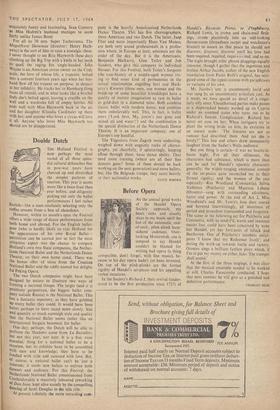Double Dutch
However, within its month's span the Festival offers a wide range of dance performances from both home and abroad. For the English ballet-
80e (who is hardly likely to visit Holland for the appearances of his own Royal Ballet—
Patriotism can be carried just so far) the most attractive aspect was the chance to compare Holland's own two State companies, the Nether- lands National Ballet and the Netherlands Dance Theatre, on their own home canal. There was the bonus offer of visits from the Croatian National Ballet and the oddly-named but delight, ful'Peking Opera.
The two Dutch companies might have been designed by nature to illustrate two ways of forming a national troupe. The larger (and it is Positively gargantuan, the biggest ballet com- Pally outside Russia) is the National Ballet. This has a fantastic repertory, as they have gobbled UP every ballet they could. It would have been ' better perhaps to have raced more slowly. Size and quantity so much outweigh style and quality that the National Ballet seems rather like an international bargain basement for ballet.
One day, perhaps, the Dutch will be able to Perform the Shadows scene from La Bayadere,
but not this year, nor next. It is a fine, even essential, thing for a national ballet to be a museum, but its exhibits have to be assembled With care and knowledge, they have to be fondled with style and caressed with love. But, of course, a national ballet can't be just a
Musetun; it needs new ballets to enliven both dancers and audience. For this Festival, the Netherlands National Ballet commissioned from Czechoslovakia a massively laboured reworking of Don Juan, kept alive mainly by the compelling. dancing of Scott Douglas in the title role.
At present it.finitely the more rewarding cora-
pany is the heavily Americanised Netherlands Dance Theatre. This has five choreographers, three American and two Dutch. The latter, Jaap Flier and more importantly Hans Van Manen, are both very sound professionals in a profes- sion where, in Europe at least, amateurs are the order of the day. But it is the Americans, Benjamin Harkarvy, Glen Tetley and Job Sanders, who give this company its individual flavour. For this-Festival, both Tetley's Sargasso (the case-history of a middle-aged woman try- ing to find some kind of permanence in the sexual relationships engulfing her) and Hark- arvy's Kwartet (three men, one woman and the break-up of some beautiful friendships) have a quality of mature imagination as rare in ballet as gold-dust in a diamond mine. Both combine classic ballet with modern dance, and combine them unbelievably well. This, in fact, is ballet news ('Look here, Ma, junior's just gone and mixed oil and water!') and the combination is the special distinction of the Netherlands Dance Theatre. It is an important company; one of Europe's top handful.
The Yugoslays from Zagreb were endearing; weighed down with ungainly rocks of choreo- graphy, yet cheerfully, if splutteringly, keeping afloat through sheer, basic dance ability. They need more training (where are all their fine dancers gone? Some of them should be back working on the next generation) and more ballets, but, like the Belgrade troupe, they score heavily
























 Previous page
Previous page